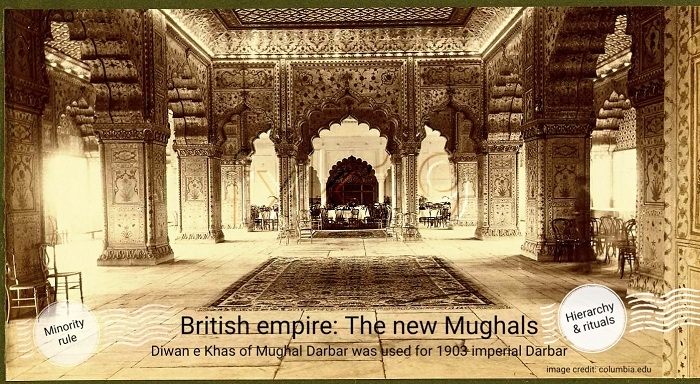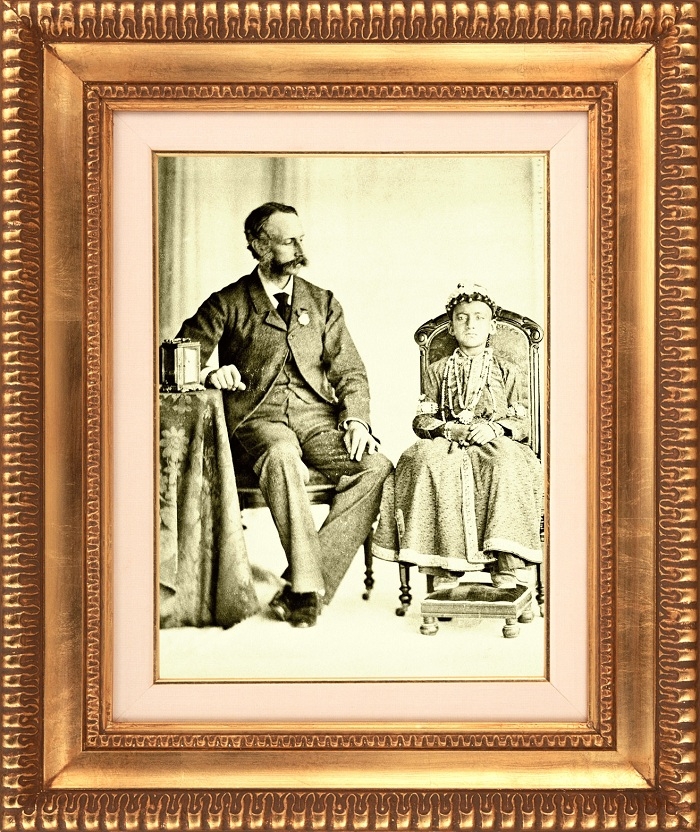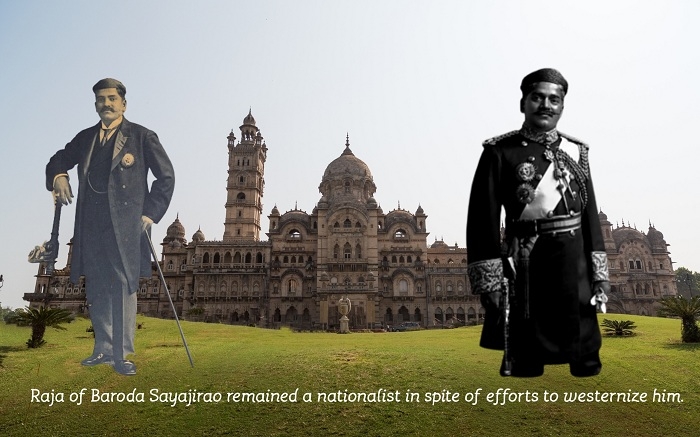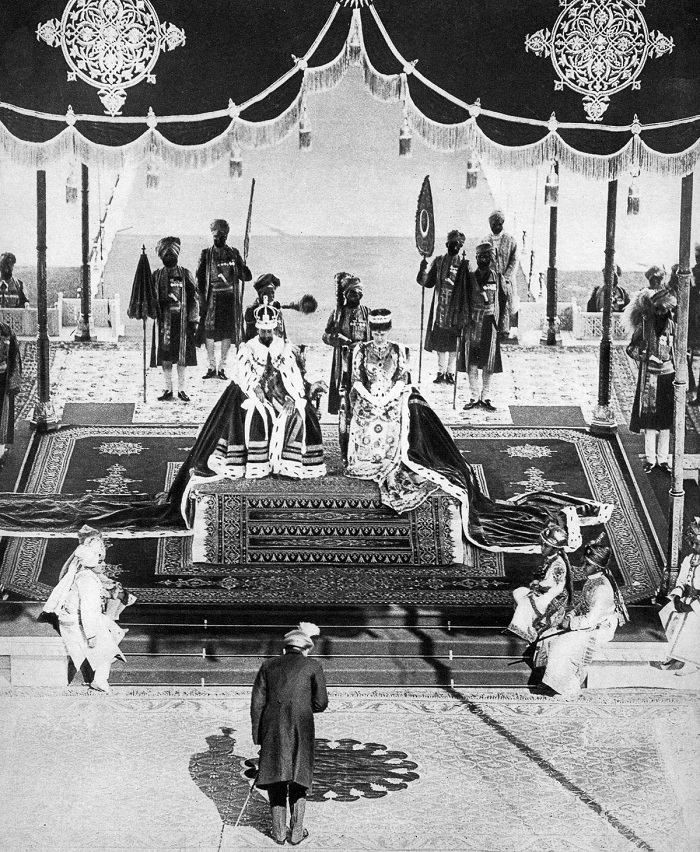Princely States and British empire: a velvet subjugation
06 Mar 2023 08:42:55

Pre 1857 :The phase of annexation
As we have seen in the article
The major powers were annexed by the empire. But as history shows, even the oppressor finds a raison d'être for his acts. The British invented the so called 'doctrine of lapse'. It means
"where heirs natural shall fail, the territory should be made to lapse and adoption should not be permitted".
Thus the Satara, Nagpur kingdoms, Delhi sultanat and many small States were finished using this doctrine in a suitable way in each case. The Raja of Satara had adopted a son prior to his death in 1847. Despite this formal adoption, the Company refused to acknowledge the adopted son as legitimate heir and the Governor-General further justified annexation on the grounds that the Company had created the state and it could be annexed at the companies convenience. In the case of Nagpur, the ruler had no son, natural or adopted, and the Company annexed the state on the Raja’s death in 1853. In 1856 the Company got the opportunity to finish Mughal dynasty when the heir apparent predeceased his father. The Company refused to recognise the Emperor’s choice of another son as heir. Actually the Company intended to abolish the dynasty altogether on the death of Bahadur Shah. In a parallel case, company refused to acknowledge the adopted son of Jhasi Prince in 1853. In 1857, the Mughal emperor and the Jhasi queen emerged as major rallying points for the uprising against the British.
After 1857: the pretence for encroachment
The shock waves of the 1857 revolt dramatically transformed things. The rebellion was suppressed with cruelty but the East India company also suffered a deadly blow as the Indian empire was transferred to the British crown. The downward trend became irreversible until the dissolution of the company by British Parliament in 1874. On the other hand the Queens declaration of 1858 emphatically declared status quo policy. Thereafter the annexation ceased to be an option at least as a general rule. The new tool to encroch upon the Princely States was minority rule by political agent.
The minority rule
As a follow-up of the Queen's proclamation, Sanads were distributed to about 200 of about 600 Princes, 'granting' them the right to adopt a child in accordance with Hindu and Muslim customs and laws. But adoption sanads came with a sting in the tale. While they assured the preservation of princely dynasties, they also proclaimed that ‘the British Government will recognise and confirm any adoption of a successor made by yourself or by any future Chief of your state.'
Using this provision the British political agents deviced the means to encroach. The adoption would be sanctioned with the condition that until the adopted child comes of age, the State will be ruled by the British political agent. The following graph shows the number of States under 'minority rule', i.e. the British political agents rule for the time period shown on the graph.
This is the data mainly of major 250 States. It can be easily inferred that at any given time 20 % of major States used to be under direct British control.

In western India, during the peak year of 1876–77, almost half of the total princely area, twenty-eight states with a combined area of 24000 square miles, was under minority administration.
But still there were a large number of States and Princes not affected by the minority rule. To influence them, education was used as a tool to mould the Princes under British influence.
Creating a Rajkumar: the British way

For influential States, special tutors and high ranking British residents were invested to mould the Princes. In large and powerful principalities such as Baroda, Hyderadad and Mysore many tutors were selected from the Indian Civil Service. Frederick Elliott of the Bombay Civil Service was personal tutor to the Gaekwar of Baroda and the Maharajas of Kolhapur and Bhavnagar were put under the tuition of Stuart Fraser, also of the Bombay Civil Service, who then became tutor to the minor Maharaja of Mysore. Brian Egerton, District Superintendent of Police in Ajmer, was tutor to both the Maharaja of Bikaner and the Nizam of Hyderabad, and J. W. D. Johnstone of the Education Department of the Government of India was tutor to Scindia, Maharajah of Gwalior. The intention was very clear. As Colonel mallison, the guardian of Mysore Maharaja wrote in his letter to Secretary of British Government of India in 1875, the ideal candidate as a tutor should be
"a gentleman fresh from one of the English universities ... of high character and attainments, totally unconnected with India. A greater mistake could not be committed than to appoint to that office any one directly connected with an Indian family, ..........What is required for the Maharajah is the influence of an unfettered, unprejudiced English intellect....."
However, with their usual human resource crunch, it was not possible to provide personal tutors of high quality to all the Princes. The solution arrived at was the creation of a series of Rajkumar colleges, where only Princes, other selected children of high officials from the Princely States and children of very big Zamindars were given admission. This was an attempt to create a version of Eton in India and to create a class equivalent to British nobility and lords, which will remain loyal to the British empire.

Thus a series of colleges were established. Rajkumar college at Rajkot in 1870, Mayo college at Ajmer in 1872, Aitchison College at Lahore in 1886, Daly College at Indore in 1898, Rajkumar college at Raipur in 1892. Funded by the Princes enthusiastically, the colleges were managed by high profile persons. For example, the Mayo College council included the Viceroy, the Agent to the Governor-General in Rajputana, the Commissioner of Ajmer, seventeen rulers of Rajputana and political officers to the states involved. The college environment mimicked British schools in every way except quality of education.
Huge campuses, palatial buildings, polo grounds adored the institutions. Mixed with the traditional lavishness of the Princely families, they created a curious picture. In 1875, when the residential facilities of Mayo college were not yet developed, the Maharaja of Alwar, as a student lived in a nearby house and commuted to his daily studies on an elephant. He also had a stable of over twenty polo ponies and four carriage horses. Maharajah of Kotah arrived at Mayo with 200 followers, for whom a special village was built. Everything was stupendous except education. As Caroline Keen observes and quotes in 'Power behind the throne'
"Much of the curriculum was of ‘dubious relevance’ to the education of Indian princes. The teaching of English was not as thorough as it might have been and general studies suffered from a lack of goals."
By the end of Century, a generation of such 'educated' Princes had assumed power in various Princely States. ‘Chiefs and Ruling Families of Rajputana’ published in 1894 mentions more than 25 young rulers from Rajputana as having attended Mayo College.
The policy reaped rich dividends for the empire. Just one example is sufficient to illustrate the point. Raja Martanda of Pudukottai, throughly educated by a personal British tutor from 1886, assumed full powers with his accession to the throne in 1894. In August 1897 a letter from the Madras Government declared that
"the Raja is more like a coloured European gentleman, with entirely European tastes, than a Native Prince"But as to his actual duties as a Prince, it was noted that" the Rajah was always knocking about amusing himself and but seldom troubles Pudokkottai with his presence ... Mr. Crossley has, I fear, done him no good of late, and instead of pressing him to buckle down to the task of governing has encouraged him to do quite the reverse..."
Of course this perception presented in the report itself may not be true and surely not every Prince turned into a tool of the empire. Much more diplomatic way was to create divisions and hierarchies among the Princes.
Echoes of Mughal Darbar: hierarchies and rituals of the empire
After 1958, as the British crown took over the Indian empire, the Governor general Canning undertook a series of tours, where the Princes and other distinguished persons were assembled, Sanads were distributed to Princes and honours and rewards such as Rajah, Nawab and Rai Sahib were presented to Indians who had demonstrated loyalty to the British in the 1857 mutiny. This was a precursor to the upcoming Darbars. It was a replica of Mughal Darbar where the person to be honoured offered nazar (gold coins) and/or peshkash (valuables such as elephants, horses, gold or other precious objects). The emperor, or his deputy, would present khilats, which consisted of specific and ordered sets of clothes, but could also include horses and elephants.
The Sanads created a hierarchy within the States of those having the 'right' of adoption and those not having it. Then onwards, through the Imperial Assemblage at Delhi in 1877 when Queen Victoria was declared Kaiser-e-Hind and, later, through the Imperial Durbar of 1902 in london and at Delhi in 1903 to proclaim Edward VII Emperor of India, and in the Delhi Darbar of 1911 to honor King George V, sofisticated rituals were developed for Princes including the clothes they wore, the weapons they could carry, the number of retainers and soldiers that could accompany them to the viceroy's camp, where they were met by British officials in relation to the camp, the number of gun salutes fired in their honour, the time of the entry into the durbar hall or tent, whether the viceroy would rise and come forward to greet them, where they would be seated, how much nazar they could give and whether they would be entitled to a visit from the viceroy.

The details would define their position within the hierarchy, with the Queen or King at the top, the viceroy at the next level and all Princes at various hierarchical level. The prominent hierarchy was of the number of Gun salutes assigned to the State. Selected States were honored ranging from maximum 21 gun salute States to minimum 9 gun salute States, while a major bulk of small States had no gun salute. The States or Princes were elevated or degraded to more or less gun salute according to the 'pleasure' of the empire. To put the ritual into perspective, Queen Victoria had a salute of 101 guns, The governor-general, or the viceroy as he was designated after 1858, with other members of the British royal family, enjoyed the salute of thirty-one guns, governors of the three British presidencies were assigned seventeen guns salute and so on.
All these Darbars obnoxiously emphasized the paramount position of empire with British as the new Mughals. At the same time, many Princes found it quite humiliating. On the occasion of Royal Darbar at london on 4 July 1902, in the presence of 3000 invited dignitaries from all around the world, the Indian Princes were made to pass in procession before the Prince of Wales and were made to offer him profound obeisance while standing in semi circular position in front of him. At the Delhi darbar in 1911, some Princes were assigned the duty to hold the folds of the King's and Queen's gown when they were walking.
With such domination, the empire was ready to squeeze as many benifits from the Princely States as possible. To what extent they could do it is the topic of our upcoming article.